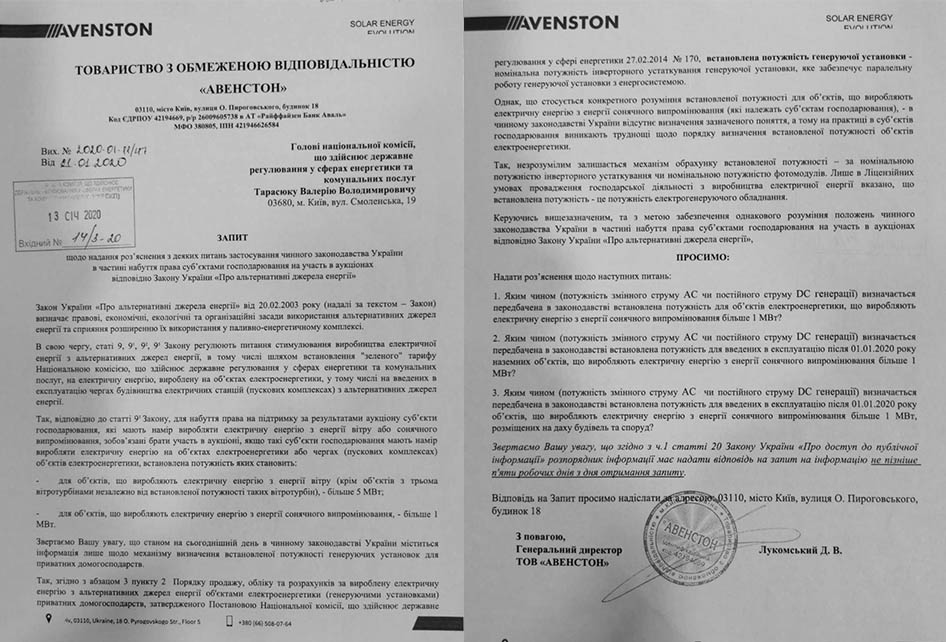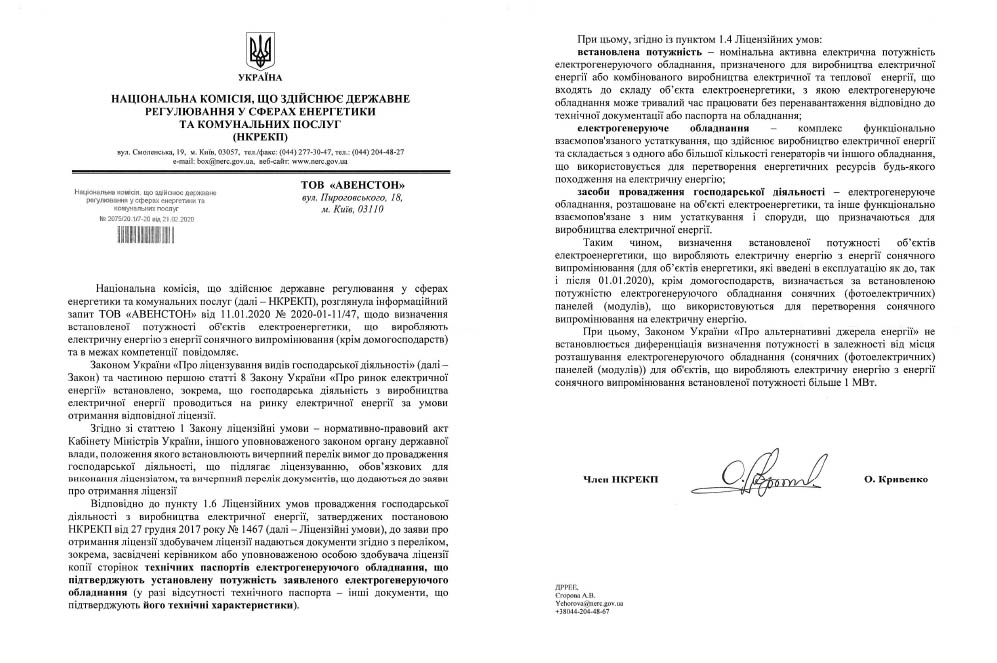AVENSTON, as an experienced participant in the solar energy market in Ukraine, is always at the epicenter of events and has a constructive dialogue with all stakeholders in the energy industry. Also, we actively communicate with government agencies to formulate clear and transparent operating rules and to achieve sustainable development of the solar energy sector in the Ukrainian market.
In early 2020, our legal department sent a letter to the National Commission for state regulation in the energy and utilities (NKREKP) to clarify an important issue for investors – the issue of the mechanism for calculating installed capacity for entities that generate electricity from solar energy and are owned by legal entities. For example, if an investor decides to build a solar power plant and sell electricity at a green tariff, rather than through an auction system, then the limitation of such a plant in terms of installed capacity will be 1 MW. The only question is, 1 MW per AU or DC? This question is fundamental, because everything from the technical specifications to the design and selection of basic equipment will depend on this mechanism.
Let’s clarify. To date, the current legislation of Ukraine contains information only on the mechanism for determining the installed capacity of generating installations for private households *. However, as regards the specific understanding of installed capacity for solar energy generating entities (belonging to economic entities), the current legislation of Ukraine does not define this concept, and therefore, in practice, economic entities arise difficulties to determine the installed capacity of power objects – by the installed capacity of the inverter equipment or the installed capacity of the photo modules.
In a letter to the NKREKP, the AVENSTON Law Department requested clarification on the following issues:
- How is determined (AC or DC power generation) the prescribed by law installed capacity for electric power plants that produce electricity from solar radiation energy and exceed 1 MW?
- How is determined (AC or DC power generation) the prescribed by law installed capacity for electric power plants that produce electricity from solar radiation energy and exceed 1 MW, ground objects put into operation after 01/01/2020?
- How is determined (AC or DC power generation) the prescribed by law installed capacity for electric power plants that produce electricity from solar radiation energy and exceed 1 MW, roofed objects put into operation after 01/01/2020?

In an official response to AVENSTON, the regulator refers to the Law of Ukraine “On Licensing of Business Activities”, namely Article 1, clauses 1.6 and 1.4, and the first part of Article 8 of the Law of Ukraine “On the Electricity Market”. Thus, the installed capacity of electricity facilities producing electricity from solar energy (for energy facilities commissioned before and after 01.01.2020), other than households, is determined by the installed capacity of the power generating equipment solar (photoelectric) panels (modules) used to convert solar radiation into electrical energy. At the same time, the Law of Ukraine “On Alternative Energy Sources” does not establish differentiation of installed capacity determination depending on the location of the power generating equipment (solar (photoelectric) panels (modules)) of electric power plants that produce electricity from solar radiation energy and exceed 1 MW.
The full text of the regulator’s written response provide below.

AVENSTON is grateful for the clear and unambiguous response to the Regulator. Our team looks forward to fruitful work with all authorities, which will allow the market to grow and attract investment.
As never before, solar market players need to coordinate activities and protect common interests. For this purpose, the Solar Energy Association of Ukraine (ASEU) was created in due time, which protects the interests of all its participants and players of the market, and not only of individual legal entities and large companies. Today, AVENSTON is a member and partner of the Association. Together we are engaged in intensive and fruitful joint work on the development of solar electricity in Ukraine.
We encourage everyone whose activities are related to the sun to unite in a single ASEU family, because any difficulties can be overcome only through joint efforts and systematic teamwork.
* The Law of Ukraine “On Alternative Energy Sources” of 20.02.2003, Article 9, paragraph 3, paragraph 2 refers to the Procedure for sale, accounting and payments for produced electricity from alternative energy sources by electricity objects (generating installations) of private households approved by the Resolution Of the National Commission for State Regulation in the Energy Sector 27.02.2014 No. 170. Installed capacity of the generating installation is a rated power of the inverter equipment of the generating plant, which provides a parallel work of generating installation with the grid.